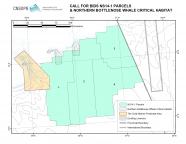Environment
An Environmental Assessment (EA) is required as part of the activity authorization for exploration and development programs in the Nova Scotia Offshore. The EA process predicts environmental effects of proposed physical activities before they are carried out. EAs identify potential adverse environmental effects, propose measures to mitigate adverse environmental effects, predict whether there will be significant adverse environmental effects after mitigation measures are implemented, and include a follow-up program to verify the accuracy of the environmental assessment and the effectiveness of the mitigation measures.
EAs in the Nova Scotia offshore area are governed by the Federal/provincial Accord Acts and the Canadian Environmental Assessment Act (CEAA 2012). Part III of the Accord Acts promotes environmental protection. Accord Act EA processes include application to seismic programs. CEAA 2012 applies to “Designated Projects” as defined by that law, namely exploration drilling programs, development programs and some decommissioning programs.
A Strategic Environmental Assessment (SEA) for exploration activities was completed in 2012, which encompasses the parcels. It is recommended that the SEA be used by operators to assist in their preparation of project specific environmental assessments. Strategic Environmental Assessment for Offshore Petroleum Exploration Activities – Eastern Scotian Slope (Eastern Portion) and Laurentian Fan (Western Portion) (Phase 2B).
Species at Risk
The Lands are located within the distributional range of the northern bottlenose whale, Scotian Shelf population, listed as Schedule 1 Endangered under the Species at Risk Act (SARA). Any approved activity within this distributional range may require enhanced mitigation and may include certain limitations to protect individuals of this species. Furthermore, the Lands include a portion of Shortland Canyon and Haldimand Canyon, and are in the proximity of Zone 1 of the Gully Marine Protected Area. These three areas have been identified as critical habitat for the northern bottlenose whale under SARA. Any approved activity within or near these areas may require enhanced mitigation and may include certain limitations to avoid the destruction of critical habitat.
There is increased potential for interaction with the northern bottlenose whale in, and adjacent to, the critical habitat area. Project specific EAs will be required to address this increased potential for interaction. Bidders are also strongly encouraged to gain an understanding of the Species at Risk Act, which is enforced by DFO, Environment Canada and/or Parks Canada. The Act is available by clicking here: http://laws-lois.justice.gc.ca/eng/acts/S-15.3/index.html.
Statement of Canadian Practice with Respect to the Mitigation of Seismic Sound in the Marine Environment (the Statement)
The mitigative measures contained in this Statement were developed based on available scientific knowledge and are considered to be current best practice for minimizing potential adverse impacts of seismic activities that use air source arrays. The statement is taken into account during regulatory reviews which include the environmental assessment processes. Operators of seismic operations will be required to provide rationale for any modifications or variations to the mitigative measures that are set out in the Statement for consideration by the CNSOPB. The Statement and a background paper are available at http://www.dfo-mpo.gc.ca/oceans/management-gestion/integratedmanagement-gestionintegree/seismic-sismique/index-eng.asp. As noted above, any approved activity within or near critical habitat areas may require enhanced mitigation above and beyond the Statement.


